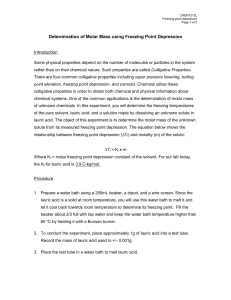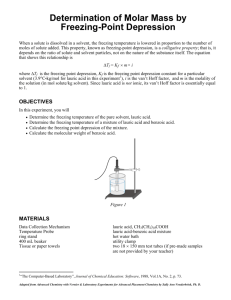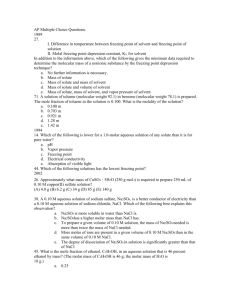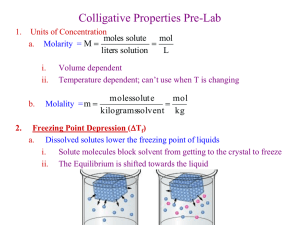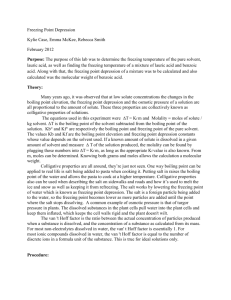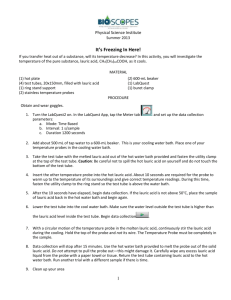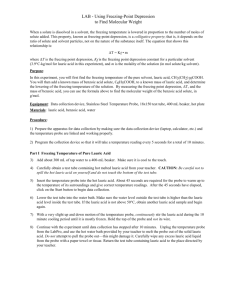Determination of Molar Mass by Freezing-Point
advertisement
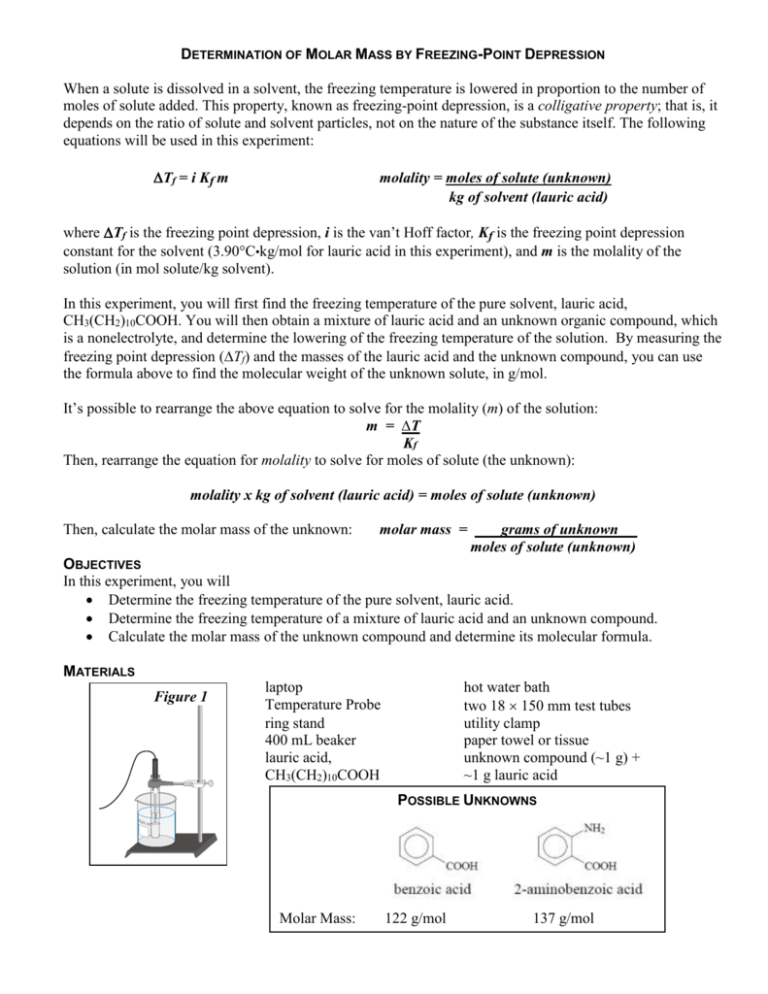
DETERMINATION OF MOLAR MASS BY FREEZING-POINT DEPRESSION When a solute is dissolved in a solvent, the freezing temperature is lowered in proportion to the number of moles of solute added. This property, known as freezing-point depression, is a colligative property; that is, it depends on the ratio of solute and solvent particles, not on the nature of the substance itself. The following equations will be used in this experiment: Tf = i Kf m molality = moles of solute (unknown) kg of solvent (lauric acid) whereTf is the freezing point depression, i is the van’t Hoff factor, Kf is the freezing point depression constant for the solvent (3.90°C•kg/mol for lauric acid in this experiment), and m is the molality of the solution (in mol solute/kg solvent). In this experiment, you will first find the freezing temperature of the pure solvent, lauric acid, CH3(CH2)10COOH. You will then obtain a mixture of lauric acid and an unknown organic compound, which is a nonelectrolyte, and determine the lowering of the freezing temperature of the solution. By measuring the freezing point depression (Tf) and the masses of the lauric acid and the unknown compound, you can use the formula above to find the molecular weight of the unknown solute, in g/mol. It’s possible to rearrange the above equation to solve for the molality (m) of the solution: m = ∆T Kf Then, rearrange the equation for molality to solve for moles of solute (the unknown): molality x kg of solvent (lauric acid) = moles of solute (unknown) Then, calculate the molar mass of the unknown: molar mass = grams of unknown f moles of solute (unknown) OBJECTIVES In this experiment, you will Determine the freezing temperature of the pure solvent, lauric acid. Determine the freezing temperature of a mixture of lauric acid and an unknown compound. Calculate the molar mass of the unknown compound and determine its molecular formula. MATERIALS Figure 1 laptop Temperature Probe ring stand 400 mL beaker lauric acid, CH3(CH2)10COOH hot water bath two 18 150 mm test tubes utility clamp paper towel or tissue unknown compound (~1 g) + ~1 g lauric acid POSSIBLE UNKNOWNS Molar Mass: 122 g/mol 137 g/mol PROCEDURE 1. Obtain and wear goggles. 2. Connect a Temperature Probe to Channel 1 of the Vernier computer interface. Connect the interface to the computer with the proper cable. 3. Start the Logger Pro program on your computer. Open the file “04 Freezing Point” from the Advanced Chemistry with Vernier folder. Part I: Determine the Freezing Temperature of Pure Lauric Acid 4. Add about 300 mL of tap water with a temperature of 20-25°C to a 400 mL beaker. Place the beaker on the base of the ring stand. 5. Use a utility clamp to obtain a test tube containing hot, melted lauric acid from your instructor. Fasten the utility clamp at the top of the test tube. CAUTION: Be careful not to spill the hot lauric acid on yourself and do not touch the bottom of the test tube. 6. Insert the Temperature Probe into the hot lauric acid. Fasten the utility clamp to the ring stand so the test tube is above the water bath. Click to begin the data collection. 7. Lower the test tube into the water bath. Make sure the water level outside the test tube is higher than the lauric acid level inside the test tube, as shown in Figure 1. 8. With a very slight up-and-down motion of the Temperature Probe, continuously stir the lauric acid for the ten-minute duration of the experiment. 9. When the data collection is complete, use a hot water bath to melt the lauric acid enough to safely remove the Temperature Probe. Carefully wipe any excess lauric acid liquid from the probe with a paper towel or tissue. 10. The freezing temperature can be determined by finding the mean temperature in the portion of the graph with nearly constant temperature. Move the mouse pointer to the beginning of the graph’s flat part. Press the mouse button and hold it down as you drag across the flat part of the curve, selecting only the points in the plateau. a. Click the Statistics button, . b. The mean temperature value for the selected data is listed in the statistics box on the graph. Record this value as the freezing temperature of pure lauric acid. c. Click on the upper-left corner of the statistics box to remove it from the graph. Part II Determine the Freezing Temperature of an Impure Lauric Acid Sample 11. Prepare the computer for data collection. a. From the Experiment menu, choose Store Latest Run. This stores the data so it can be used later. b. To hide the curve of your first data trial, click the Temperature y-axis label of the graph and choose More…. from the dropdown list. Uncheck the Run 1 Temperature box and click . 12. Obtain a test tube containing a melted solution with ~1 g of the unknown compound dissolved in ~ 1 g of lauric acid. Record the precise masses of the unknown and lauric acid as indicated on the label of the test tube. Repeat Steps 4–9. 13. The freezing temperature of the unknown compound-lauric acid solution can be determined by finding the temperature at which the mixture initially started to freeze. Unlike pure lauric acid, the mixture results in a gradual linear decrease in temperature Freezing Point during freezing. Follow the steps below to analyze the graph. a. Click and drag the mouse to highlight the initial part of the cooling curve where the temperature decreases rapidly (before freezing occurred). b. Click on the Linear Regression button, . c. Now click and drag the mouse over the next linear region of the curve (the Time gently sloping section of the curve where freezing took place). d. Click again. The graph should now have two regression lines displayed. e. Choose Interpolate from the Analyze menu. Move the cursor to the point of intersection of the two lines; you will know if the cursor is over the intersection when the temperature readings displayed in the interpolate box are the same. This is the freezing point of the unknown compound-lauric acid mixture. f. Record the freezing point in your data table. 14. Print a graph showing both trials. DATA Trial 1 Trial 2 Mass of lauric acid in mixture (kg) Mass of unknown in mixture (g) Freezing point of pure lauric acid (°C) Freezing point of the unknown compound-lauric acid mixture (°C) Freezing point depression, ∆T, of mixture (°C) Molality, m, of mixture (mol solute/kg solvent) Moles of unknown in mixture (mol) Experimental molar mass of unknown (g/mol) Name of unknown Accepted molar mass of unknown (g/mol) % Error ANALYSIS (SHOW CALCULATIONS FOR ONE OF THE TRIALS ONLY) 1. Determine the freezing point depression, ∆T, after adding your unknown into the pure lauric acid. 2. Calculate the molality (m) of the solution. Keep in mind that you can’t have a negative molality. 3. Calculate the moles of unknown. 4. Calculate the experimental molar mass of your unknown. 5. Identify your unknown compound and calculate the percent error between the experimental and accepted values. DISCUSSION & CONCLUSION Be sure to include possible sources of error and how those sources of error would have affected your experimentally determined molar mass. What could have made your molar mass higher than it should have been? What could have made your molar mass lower than it should have been? EXTENSION QUESTION (PART II QUESTION BASED ON THIS LAB) The molar mass of an unknown solid, which is nonvolatile and a nonelectrolyte, is to be determined by the freezing-point depression method. The pure solvent used in the experiment freezes at 10C and has a known molal freezing-point depression constant, Kƒ. Assume that the following materials are also available. • test tubes • thermometer • stirrer • balance • pipet • beaker • stopwatch • ice • graph paper • hot-water bath (a) Using the two sets of axes provided below, sketch cooling curves for (i) the pure solvent and for (ii) the solution as each is cooled from 20C to 0.0C Pure Solvent Solution (b) Information from these graphs may be used to determine the molar mass of the unknown solid. (i) Describe the measurements that must be made to determine the molar mass of the unknown solid by this method. (ii) Show the setup(s) for the calculation(s) that must be performed to determine the molar mass of the unknown solid from the experimental data. (iii) Explain how the difference(s) between the two graphs in part (a) can be used to obtain information needed to calculate the molar mass of the unknown solid. (c) Suppose that during the experiment a significant but unknown amount of solvent evaporates from the test tube. What effect would this have on the calculated value of the molar mass of the solid (i.e., too large, too small, or no effect)? Justify your answer. (d) Show the setup for the calculation of the percentage error in a student’s result if the student obtains a value of 126 g mol-1 for the molar mass of the solid when the actual value is 120. g mol-1.
